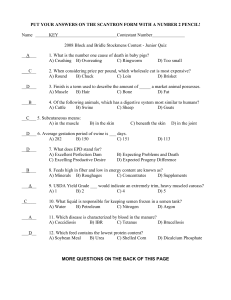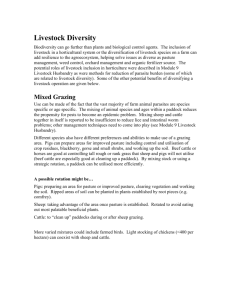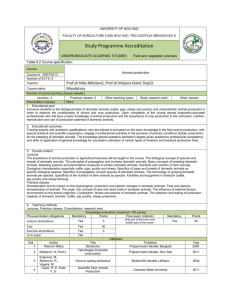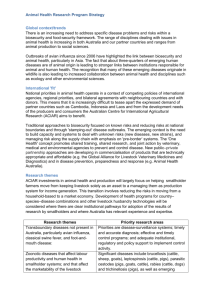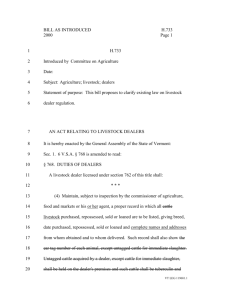BEHAVIORAL PRINCIPLES OF LIVESTOCK HANDLING
advertisement
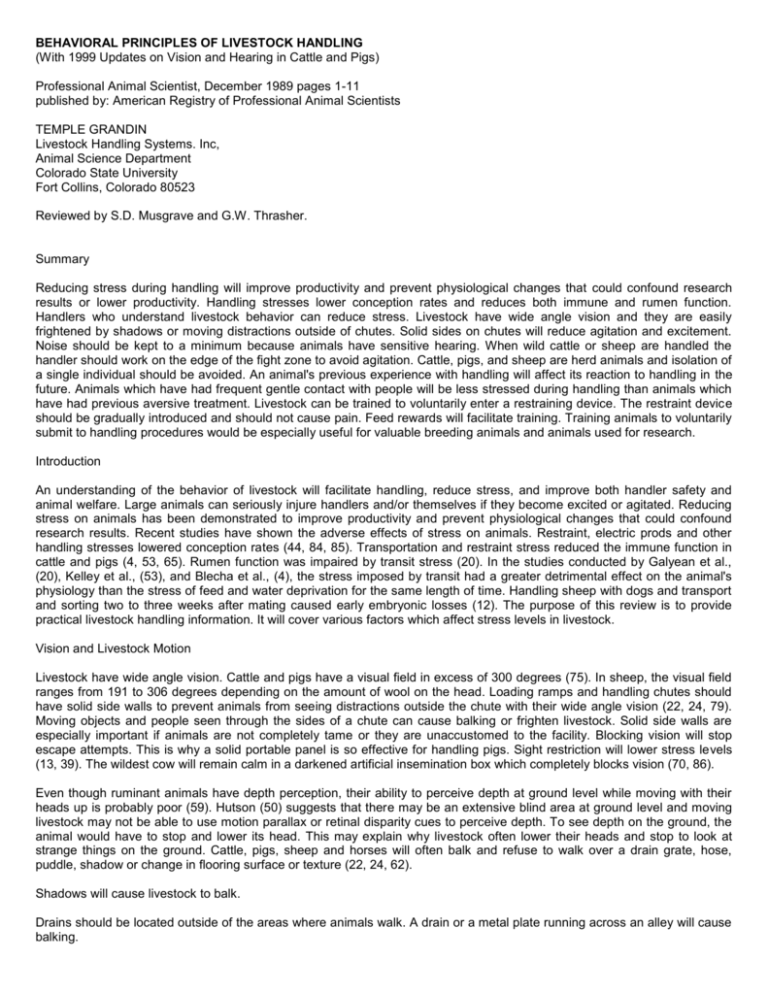
BEHAVIORAL PRINCIPLES OF LIVESTOCK HANDLING (With 1999 Updates on Vision and Hearing in Cattle and Pigs) Professional Animal Scientist, December 1989 pages 1-11 published by: American Registry of Professional Animal Scientists TEMPLE GRANDIN Livestock Handling Systems. Inc, Animal Science Department Colorado State University Fort Collins, Colorado 80523 Reviewed by S.D. Musgrave and G.W. Thrasher. Summary Reducing stress during handling will improve productivity and prevent physiological changes that could confound research results or lower productivity. Handling stresses lower conception rates and reduces both immune and rumen function. Handlers who understand livestock behavior can reduce stress. Livestock have wide angle vision and they are easily frightened by shadows or moving distractions outside of chutes. Solid sides on chutes will reduce agitation and excitement. Noise should be kept to a minimum because animals have sensitive hearing. When wild cattle or sheep are handled the handler should work on the edge of the fight zone to avoid agitation. Cattle, pigs, and sheep are herd animals and isolation of a single individual should be avoided. An animal's previous experience with handling will affect its reaction to handling in the future. Animals which have had frequent gentle contact with people will be less stressed during handling than animals which have had previous aversive treatment. Livestock can be trained to voluntarily enter a restraining device. The restraint device should be gradually introduced and should not cause pain. Feed rewards will facilitate training. Training animals to voluntarily submit to handling procedures would be especially useful for valuable breeding animals and animals used for research. Introduction An understanding of the behavior of livestock will facilitate handling, reduce stress, and improve both handler safety and animal welfare. Large animals can seriously injure handlers and/or themselves if they become excited or agitated. Reducing stress on animals has been demonstrated to improve productivity and prevent physiological changes that could confound research results. Recent studies have shown the adverse effects of stress on animals. Restraint, electric prods and other handling stresses lowered conception rates (44, 84, 85). Transportation and restraint stress reduced the immune function in cattle and pigs (4, 53, 65). Rumen function was impaired by transit stress (20). In the studies conducted by Galyean et al., (20), Kelley et al., (53), and Blecha et al., (4), the stress imposed by transit had a greater detrimental effect on the animal's physiology than the stress of feed and water deprivation for the same length of time. Handling sheep with dogs and transport and sorting two to three weeks after mating caused early embryonic losses (12). The purpose of this review is to provide practical livestock handling information. It will cover various factors which affect stress levels in livestock. Vision and Livestock Motion Livestock have wide angle vision. Cattle and pigs have a visual field in excess of 300 degrees (75). In sheep, the visual field ranges from 191 to 306 degrees depending on the amount of wool on the head. Loading ramps and handling chutes should have solid side walls to prevent animals from seeing distractions outside the chute with their wide angle vision (22, 24, 79). Moving objects and people seen through the sides of a chute can cause balking or frighten livestock. Solid side walls are especially important if animals are not completely tame or they are unaccustomed to the facility. Blocking vision will stop escape attempts. This is why a solid portable panel is so effective for handling pigs. Sight restriction will lower stress levels (13, 39). The wildest cow will remain calm in a darkened artificial insemination box which completely blocks vision (70, 86). Even though ruminant animals have depth perception, their ability to perceive depth at ground level while moving with their heads up is probably poor (59). Hutson (50) suggests that there may be an extensive blind area at ground level and moving livestock may not be able to use motion parallax or retinal disparity cues to perceive depth. To see depth on the ground, the animal would have to stop and lower its head. This may explain why livestock often lower their heads and stop to look at strange things on the ground. Cattle, pigs, sheep and horses will often balk and refuse to walk over a drain grate, hose, puddle, shadow or change in flooring surface or texture (22, 24, 62). Shadows will cause livestock to balk. Drains should be located outside of the areas where animals walk. A drain or a metal plate running across an alley will cause balking. In areas where animals are handled, illumination should be uniform and diffuse. Shadows and bright spots should be minimized. Slats on the floor of shearing sheds and other animal facilities, should be eliminated so animals walk across the slats (48). Flapping objects or a coat hung on a chute fence may stop animal movement. Pigs, sheep, and cattle have a tendency to move from a dimly illuminated area to a more brightly illuminated area, provided the light is not glaring in their eyes (22, 62, 90). A spot light directed onto a ramp or other apparatus will often facilitate entry. The light must not shine directly into the eyes of approaching animals. Recent research by Phillips et al., (74) indicated that pigs reared indoors preferred to walk up a ramp illuminated at 80 lux which was similar to the illumination of the rearing quarters. A dimly illuminated ramp with less than 5 lux was avoided. There was also a tendency to avoid an excessively bright ramp illuminated with 1200 lux. Moving or flapping objects can also disrupt handling. Fan blades or a flapping cloth can cause balking. Animals may refuse to walk through a chute if they can see motion up ahead (31). Livestock have color perception. Numerous investigators have now confirmed that cattle, pigs, sheep and goats all possess color vision (9, 10, 19, 40, 58, 68). Handling facilities should be painted one uniform color. All species of livestock are more likely to balk at a sudden change in color or texture. -----------------------------------------------------------------------1999 Vision Update The latest research on color vision in farm animals shows that they are dichromats with cones (color sensitive retina cells) most sensitive to yellowish-green (552-555 nm) and blue pruple light (444-445 nm)2. Humans are trichromats and see the full color spectrum. Dichromatic vision may make the animal more sensitive to seeing sudden movement4,5. It may explain why grazing animals such as cattle balk at drain gates, shadows, and anything that has high contrast of light and dark. The brain's fear center which is called the amygdala is activated when an animal sees sudden movement3. One of the most common causes of balking in a handling facility is a small loose chain end that makes a rapid movement. Loose chain ends must be removed from races, chutes, and alleys. This is why people working with livestock should have slow deliberate movements. Grazing animals have a visual system that provides excellent distance vision but relatively weak eye muscles inhibit the ability to focus quickly on nearby objects. This may explain the tendency of a horse to spook at nearby sudden movement. Grazing animals also have a split shaped pupil and a visual system that is designed to be most efficient at scanning at a distance while they are grazing8. Animals will often refuse to enter a building that looks dark. This is most likely to be a problem on a bright sunny day. There are some handling facilities in buildings that work well at night or on a cloudy day, but on a sunny day the cattle may refuse to enter the building. Animals will enter a building more easily if they can see daylight in the building. Opening a door may help. Another option is to install white plastic transluscent panels which will let in lots of shadow free light. The ideal illumination should resemble a bright cloudy day. -----------------------------------------------------------------------Noise Cattle and sheep are more sensitive than people to high frequency noises (2, 56). The auditory sensitivity of cattle is greatest at 8000 hz and sheep at 7000 hz (1). The human ear is most sensitive at 1000 to 3000 hz. Unexpected loud or novel noises can be highly stressful to livestock. Sheep exposed to exploding firecrackers or noise in a slaughter plant had increased thyroid hormone levels and elevated cortisol (16, 72). A loud clanging bell from an outdoor telephone will raise a calf's heart rate 50 to 70 beats per minute (T. Camp USDA Experimental Station, College Station, Texas, personal communication). Physiological changes induced by sudden noises could alter the results of experiments. Animals will readily adapt to reasonable levels of continuous sound, such as white noise, instrumental music, and miscellaneous sounds. Continuous exposure to sounds over 100 dB reduced daily weight gain in sheep (1). However, continuous background sound can actually improve weight gain in some cases. Ames (1) found that sheep exposed to 75 dB of miscellaneous sounds (roller coasters, trains, horns, etc.), white noise, or instrumental music gained weight faster than controls without continuous background sound. Livestock producers and researchers have learned from practical experience that continuous playing of a radio with a variety of talk and music will reduce the reaction of pigs to sudden noises. Providing controlled amounts of continuous but varying background sound may help prevent weight gain losses caused by unexpected noises. In facilities where livestock are handled, loud or novel noises should be avoided because they distress livestock (31). It may be advisable to have the same radio station or background sound that is provided in the living quarters. Research is needed to determine if exposing animals to sounds such as truck noise would help reduce stress. The sound of hanging metal can cause balking and agitation (31). Rubber stops on gates and squeeze chutes will help reduce noise (26). The pump and motor on a hydraulic squeeze chute should be located away from the squeeze. Exhausts on pneumatic powered equipment should be piped away from the handling area. Small amounts of noise can be used to move livestock. Cattle and sheep will move away from a rustling piece of plastic. If sheep become excited they will not respond to this stimulus (87). -----------------------------------------------------------------------1999 Hearing Update Research by Jennifer Lanier in our research group has shown that cattle that have a flighty temperament are more likely to flinch or jump in response to sudden movements and intermittent high pitched sounds. In the auction ring, flightly cattle were more likely to startle when the ring man suddenly swung his arm when he yelled out a bid. Intermittent sounds caused piglets to react more than a steady sound6 and high pitched sounds increased a piglets' heart rate more than low pitched sounds7. Researchers in Canada found that sounds from people such as yelling or whistling had a greater effect on the heart beat of cattle than equipment sounds such as gates clanging9. Handlers can keep animals calmer if they avoid the visual and auditory stimuli that scare them. Sudden intermittent sounds and sudden jerky movement should be avoided. Handlers should use low pitched sounds to calm animals. -----------------------------------------------------------------------Flight Zone An important concept of livestock handling is flight zone. The flight zone is the animal's "personal space". When a person enters the flight zone the animals will move away (22, 31). Understanding of the flight zone can reduce stress and help prevent accidents to handlers. The size of the flight zone varies depending on the tameness or wildness of the livestock (22). The flight zone of extensively raised cows may be as much as 50m (164 ft) whereas the flight zone of feedlot cattle may be 2m (6 ft) to 8m ( 26 ft) (22). The size of the flight zone will slowly diminish when animals receive frequent, gentle handling. The edge of the flight zone can be determined by slowing walking up to the animals. The circle represents the edge of the flight zone (22). Extremely tame livestock are often difficult to drive because they no longer have a flight zone. These animals should be led with a feed bucket or halter. The size of the enclosure the livestock are confined in may affect flight zone size. Sheep experiments indicated that animals confined in a narrow alley had a smaller flight zone compared to animals confined in a wider alley (49). Approaching an animal head on will increase flight zone size (Bud Williams, personal communication). When a person enters an animal's flight zone it will move away. If the handler penetrates the flight zone too deeply, the animal will either bolt and run away, or turn back and run past the person. When the flight zone of a group of bulls was invaded by a mechanical trolley, the bulls moved away and maintained a constant distance between themselves and the trolley (54). The best place for the person to work is on the edge of the flight zone (22). This will cause the animals to move away in an orderly manner. The animals will stop moving when the handler retreats from the flight zone. To make an animal move forward, the handler should stand in the shaded area marked in the flight zone diagram (22). To cause the animal to back up, the handler should stand in front of the point of balance (57). A flag on the end of a stick can be used to sort cattle by moving it back and forth across the point of balance (57). Many people make the mistake of deeply invading the flight zone when cattle are being driven down an alley or into an enclosed area such as a crowd pen. If the handler deeply penetrates the flight zone, the cattle may turn back and run over him (3). If the cattle attempt to turn back, the person should back up and retreat from inside the flight zone. The reason why the livestock attempt to turn back is because they are trying to escape from the person who is deep inside their flight zone. When the handler is outside the flight zone the animals will turn and face the handler, and maintain a safe distance. When the handler enters the flight zone the animals will turn away. Cattle sometimes rear up and become agitated while waiting in a single file chute. A common cause of this problem is a person leaning over the chute and deeply penetrating the flight zone (25). The animal will usually settle back down if the person backs up and retreats from the flight zone. Inexperienced handlers sometimes make the mistake of attempting to push a rearing animal back down into a chute. The animal will often react to this by becoming increasingly agitated. Both the handler and the animal have a greater likelihood of being injured. This also explains why livestock will balk if they see people standing in front of the squeeze chute. The provision of shields for handlers to stand behind will improve animal movement (17, 54). Herd Animals All livestock are herd animals, and they are likely to become highly agitated and stressed when they are separated from their herd mates. Physiological changes which occur during isolation may affect productivity or research results. Isolation is a strong stresser. Restraint and isolation in a small box reduced immune response in pigs (65). In sheep and cattle isolation was highly stressful (15, 55, 80). A dairy cow left alone in a stanchion had increased leucocytes in her milk (62). During handling, isolated large animals that become agitated and excited are likely to injure handlers. Many serious cattle handling accidents have been caused by isolated frantic cattle (Grandin, 1987). If an isolated animal becomes agitated, other animals should be put in with it. Cattle and sheep are motivated to maintain visual contact with each other (14, 95). Animals will readily follow the leader. Skillful handlers allow livestock to follow the leader and do not rush them. If animals bunch up, handlers should concentrate on moving the leaders instead of pushing a group of animals from the rear. Trained sheep can be used to lead sheep through a handling facility (5). Groups of animals that have body contact remain calmer (15). A tame pacifier cow will keep a wild cow calm during artificial insemination. The wild cow will stand quietly while maintaining tactile contact with the tame cow (31). A loading ramp for pigs or sheep that has a "see through" center partition (31) takes advantage of natural following behavior. As the animals walk up the twin single file chutes, they can see each other through the center partition. Solid outer walls block outside distractions. Genetic Differences Genetic factors affect an animal's reaction to handling. Brahman and Brahman cross cattle are more excitable and hard to handle than English breeds. Angus cattle are more excitable than Herefords, and Holsteins move more slowly than Angus or Herefords (89). When Brahman or Brahman cross cattle become excited they are more difficult to block at fences (89). Visually substantial fences built with planks or a wide belly rail should be used with these breeds (31). Brahman cattle will seldom run into a fence that appears to be a solid barrier. Highly excited Brahman cattle may lie down and become immobile if they are repeatedly prodded with an electric prod. Continuous electric prodding of Brahman or Brahman cross cattle can result in death (31). If the animal is left alone for a few minutes, it will usually get up. English or European cattle such as Charolais will seldom become immobile. -----------------------------------------------------------------------1997 Update "...Brahman cattle are more excitable than the British breeds but when they are handled gently they can become extremely docile. Brahmans are inquisitive sensitive cattle that respond well to quiet gentle handling and they respond poorly and may become agitated if they are treated roughly. Since Brahman have a more reactive nervous system they may become easily frightened when subjected to sudden novel experiences. For example, going through an auction ring. Brahmans will often remain calm if they have a familiar person who can handle them when they are in a novel strange situation. British cattle on the other hand are less likely to become fearful or agitated when subjected to sudden novelty...." -----------------------------------------------------------------------In pigs, Yorkshires move more slowly during loading than Pietrians (63). Observations at farms and slaughter plants by the author indicate that certain types of hybrid pigs are difficult to drive. They have extreme shelter seeking behavior (flocking together) and they refuse to move forward up a chute. They are also very excitable. This problem is most evident in some hybrid lines of pigs selected for high productivity. Pig breeders should select for temperament to avoid serious meat quality and animal welfare problems at the slaughter plant. Different breeds of sheep also react differently to handling (82, 95). Rambouillet tend to flock tightly together and remain in the group. Cheviots are more independent than other breeds. Handler Dominance Handlers can often control animals more efficiently if they exert dominance over an animal. Exerting dominance is not beating an animal into submission. It is using the animal's natural behavior to exert dominance and the handler becomes the "Boss animal". Nomadic tribesmen in Africa control their cattle by entering the dominance hierarchy and becoming the dominant herd member (60). The author has successfully achieved dominance over a group of pigs. Slapping the dominant pig when it bit the author had little effect on its behavior. The aggressive behavior was stopped by shoving the pig against the fence with a board pushed against its neck (31). The board against the neck simulated another pig pushing and biting. Pigs exert dominance over each other by biting and pushing against the neck (45). It is often advisable to handle the dominant pig first (P.Dziuk, 1983 personal communication). The odor of the dominant pig on the handler may make the other pigs more submissive. More research is needed to develop simple methods of exerting dominance which will enable handlers to control boars and other large animals with a minimum of force and greater safety. Effect of Environment and Experience The previous experiences of an animal will affect how it will react to handling (27). An animal's stress reaction to a handling procedure such as transportation or restraint, depends on three important factors. These are as follows: genetics, individual differences, and previous experiences (11, 52, 61, 63, 77, 87). Facility design can have strong influence on previous experiences. Poor design will increase stress. Sheep raised in a team in close contact with people had a less intense physiological response to handling than sheep raised on pasture (78). Hails (38) reported that calves lost less weight the second time they were transported. Hens which were not accustomed to being caught and handled had lowered egg production. Egg production, however, was not affected in hens accustomed to frequent handling (46). Piglets accustomed to repeated gentle handling by people approached a strange person readily at 24 months of age (42). Environmental Stimulation Providing additional environmental stimulation will reduce excitability. Pigs raised in a windowless building with hanging rubber hose toys and weekly petting were less excitable compared to pigs raised with no extra environmental stimulation (31, 32) Pigs raised outdoors with a variety of playthings and daily petting were more willing to approach a strange man and walk through a narrow chute compared to pigs raised indoors in small, barren pens with minimal contact with people (29, 32). Loading pigs into a vehicle was more difficult when confinement reared pigs were handled. Pigs reared outdoors were easier to load (93). Our experiments also illustrate the different effects of environmental stimulation under different conditions. In the first trial, environmental stimulation for pigs housed in a windowless building consisted of hanging rubber hoses and weekly petting. The stimulation made the animals easier to drive through a chute and less prodding was required (29, 31, 32). In the second trial, the animals were initially very tame and both the control and extra stimulation pens were washed twice weekly with a hose. There was a tendency for the controls to be easier to drive because the petted pigs approached people for petting. Frequent pen washing provided environmental stimulation and may have helped to calm the controls. Tame animals should be led with a feed bucket or lead rope. Previous Experiences Animals remember painful or frightening experiences. Research by Hutson (51) and Pascoe (71) indicated that cattle and sheep could remember an aversive experience for many months. Sheep which had been inverted in a sheep handling machine were more difficult to move through the corrals the following year. Many months later, cattle which had experienced electro-immobilization had elevated heart rates when they approached the place where the shock had occurred. Animals can readily discriminate and make a choice between the less aversive of two different handling treatments (36, 80). Livestock which have had previous experiences with gentle handling will be less stressed when they are handled in the future. Calves accustomed to regular gentle handling had fewer injuries during marketing because they were accustomed to handling (96). Excitable cattle had lower weight gains (64). Dogs can be highly aversive to sheep (55). The use of dogs in a confined space where animals are unable to move away should be avoided. Electric prods should be used sparingly on cattle and never used on breeding pigs (31). Additional gentle methods for moving livestock are reviewed in Kilgour and Dalton (57). Cattle will be easier to handle in the future if they are not allowed to rush out of corrals back to pasture. Cattle should become accustomed to walking slowly past a handler when they exit the corrals (Bud Williams, personal communication). Cattle handled roughly in poorly designed facilities had higher heart rates compared to cattle handled calmly in well designed facilities (83). Chickens handled gently had lower plasma corticosterone levels compared to chickens handled roughly (8). Animals Feel Threatened If an animal perceives a handling procedure or contact with a person as a threat, stress may increase. Sows that withdrew from a person's hand farrowed fewer piglets than sows which readily approached a person's hand (41). When extra human contact is provided to reduce excitability the handler must be careful not to intimidate the animals. He should squat down in the pen and allow the animals to approach (29). He must never chase them. In our experiments, weight gains were not adversely affected by petting pigs in the pens or a weekly walk in the aisles. However, if the pigs feel threatened or are hurt, weight gains will be reduced. Gonyou et al. (21) found that a looming, threatening person approaching the animals reduced gains. Animals can readily adapt to handling, such as daily weighing with no effect on weight gains (73). Pumprey (76) reported that calves accustomed to daily handling by people on horses had no difference in weight gain compared to unhandled controls during cool weather. During warm weather, heat stress which occurred due to physical exertion lowered weight gains. Apparently, the animals knew the routine and did not feel threatened. If a person shocked pigs every few days a chronic stress state was created (21). Inconsistent handling will cause stress. If a handler occasionally mistreats an animal, the animal is liable to be stressed every time the person approaches. An occasional aversive treatment lowered weight gain and increased corticosteroid levels even though the handler was gentle with the pigs most of the time (43). The pigs had learned that the handler could not be trusted. Novelty can be a strong stressor. Animals that have been raised in a variable environment are less likely to be stressed when confronted with novelty. In one study veal calves were raised in indoor stalls or in outdoor group pens (R. Dantzer, personal communication, 1983). When the calves reached market weight, both groups were exposed to a new indoor and outdoor environment. Calves raised indoors had higher serum glucocorticoid values when they were put in an outdoor arena. Calves raised outdoors were more highly stressed when they were put in an indoor arena. Both of the new locations were stressful to all calves, but their reactions were influenced to the greatest extent by variance from the type of environment in which they had been reared. Animals can be trained to accept irregularity in management (78). Pigs exposed to a variety of objects approached a novel object more quickly than animals raised in a barren environment (32). However, pigs which had grown accustomed to the same routine of blood pressure testing, responded to a change in routine with increased blood pressure (67). In our previously described handling experiment, the pigs initially became highly agitated during the novel experience of pen washing (32). When they become accustomed to pen washing they walked up to be sprayed. The experience of pen washing was initially stressful but it soon became a pleasant experience that the animals actively sought. New Restraint Concept The idea of training an animal to voluntarily accept restraint is a new concept to some people. Animals that are handled gently can be trained to voluntarily accept restraint in a comfortable device (29, 33, 69). Training valuable breeding animals or animals used in long-term research studies to voluntarily enter a restraining device has many advantages. Stress on both animals and people will be reduced. Large animals that are trained to walk into a restraint device can easily be handled by one person. Cooperative large animals are less likely to injure people or themselves. Feed rewards can be used to facilitate animal movement through a facility (51). The author has trained sheep to voluntarily enter a squeeze tilt table for a grain reward (33). Some sheep were squeezed and tilted to a horizontal position nine times in one day. After being released from the squeeze tilt table, the animals rapidly ran into the crowd pen and lined up in the chute (33). To train the animals to voluntarily accept restraint, the restraint device must be introduced gradually and gently with feed rewards (33). At first, the animal is allowed to walk through the restrainer several times. The next step is to allow the animal to stand in the restrainer without being squeezed. On the fourth to fifth pass through, the squeeze is applied gently. During each step the animal is given a food reward of palatable feed. A relatively tame animal can be trained to voluntarily enter a restrainer in less than an hour. Training animals to voluntarily enter a restraint device is easier and less stressful if the animal is tame and has little or no flight zone. If a wild animal is being trained, it is important to catch it correctly on the first attempt. Fumbling and failing to restrain an animal on the first attempt will result in increased excitement (15). If an animal resists and struggles, it must not be released until it stops struggling, otherwise it will be rewarded for resisting (29). Animals that are released while resisting are more likely to resist in the future (29). The animal should be stroked and talked to gently until it calms down. Animals will not voluntarily accept restraint if the restraint device causes pain. Selection of the right type of squeeze chute and headgate to fit the specific handling requirements is important (23). The use of new designs for restraint devices should be investigated. Double rail and V restrainers that are used in meat packing plants may provide less stressful restraint for veterinary and husbandry procedures (18, 34, 81). Pigs will readily relax and fall asleep when restrained upright in a padded V restrainer. Pressure applied to the flanks will induce relaxation (37). Sheep and calves held on a double rail restrainer had low stress levels (94). The author has observed that cattle restrained with nose tongs become more difficult to restrain in the future. Further observations by the author indicated that when a halter is used to hold the animal's head for blood testing, restraining the head becomes easier with successive tests. Cattle blood-tested with halter head restraint will learn to turn their head and expose their jugular. Cattle that have had experience with nose tongs will often fling their head about to avoid attachment of the tongs. Handling Facility Layout Handling facilities that utilize behavioral principles will make handling easier. Sheep research has shown that corrals are more efficient if the animals follow the same route for procedures such as dipping and sorting (3, 47). Orienting the exit end of a sorting chute, dip vat or squeeze chute towards the "home" pasture or pen will facilitate movement Curved Chutes and Solid Fences Curved single file chutes are especially recommended for moving cattle onto a truck or squeeze chute (22, 79). A curved chute is more efficient for two reasons. First, it prevents the animal from seeing what is at the other end of the chute until it is almost there. Second, it takes advantage of the natural tendency to circle around a handler moving along the inner radius. A curved chute provides the greatest benefit when animals have to wait in line for vaccinations or other procedures. A curved chute with an inside radius 3.5m (12 ft) to 5m (16 ft) will work well for handling cattle (22). The curve must be laid out as shown. If the chute is bent too sharply at the junction between the single file chute and the crowd pen, it will appear as a dead end. This will cause livestock to balk (31). If space is restricted, short 1.5m (5 ft) bends can be used (28). If bends with a radius smaller than 3.5m (12 ft) are used, there must be a 3m (10 ft) section of straight single file at the junction between the crowd pen and chute to prevent the chute from appearing to be a dead end. Handler walkways should run alongside the chute and crowd pen (31). The use of overhead walkways should be avoided. Livestock will often balk when they have to move from an outdoor pen into a building which contains the squeeze chute. Animals will enter a building more easily if they are lined up in a single file chute before they enter the building (22). Conversely, pigs reared indoors are often reluctant to move out into bright daylight. A pig loading ramp should be designed so that the pigs are lined up in single file, where they cannot turn around before they leave the building. For all species, solid sides are recommended on both the chute and the crowd pen which leads to a squeeze chute or leading ramp (7, 22, 24, 79). For operator safety, man-gates must be constructed so that people can escape charging cattle. The crowd gate should also be solid to prevent animals from turning back (31). Wild animals tend to be calmer in facilities with solid sides. In holding pens, solid pen gates along the main drive alley facilitate animal movement. Crowd Pen Design The crowd pen used to direct animals into a single file or double file chute must never be built on the ramp. A sloped crowd pen will cause livestock to pile up against the crowd gate (26). Round crowd pens shown are very efficient for all species. In cattle facilities, a circular crowd pen and a curved chute reduced time moving cattle by up to 50 percent (92). Practical experience has shown that the recommended radius for round crowd pens is 3.5m (12 ft) for cattle, 1.83m for pigs (6 ft) and 2.4m (8 ft) for sheep. Cattle and sheep crowd pens should have one straight fence, and the other fence should be on a 30 degree angle (66). This layout should not be used with pigs. They will jam at the chute entrance. Jamming is very stressful for pigs (90). A single, offset step equal to the width of one pig should be used to prevent jamming at the entrance of a single file ramp (24, 31). Jamming can be further prevented by installing an entrance restricter at single file race entrances. The entrance of the single file chute shouldprovide only 1/2 cm on each side of each pig. More detailed information on facility layout can be found in Grandin (22, 24, 25, 28, 30). Ramp Steepness and Flooring Excessively steep ramps may injure animals. The maximum recommended steepness for a stationary cattle or pig ramp is 20 degrees for market weight animals (26). If space permits a 15 degree slope is recommended for pigs (91). Stair steps are recommended on concrete ramps because they still provide good footing when dirty or worn (31). Conclusions The use of behavioral principles should improve efficiency of livestock handling and reduce stress on animals. Reducing stress also should help improve weight gain, reproductive performance and animal health. Livestock should be handled gently with a minimum of noise. To avoid agitation the handler should work on the edge of the flight zone. Animals which have been handled gently will be less stressed by handling in the future. Restraint devices should be designed so that they do not cause pain. In certain research situations animals can be easily trained to voluntarily enter a restraint device. This practice will help reduce stress. All areas where animals are crowded such as chutes and crowd pens, should have solid sides and diffuse lighting with a minimum of shadows. http://www.grandin.com/references/new.corral.html
